Fenneman Room Geology Department University of Cincinnati
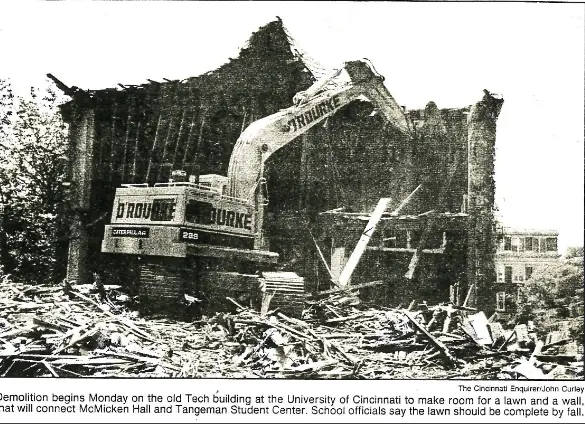
This is the Old Tech building on the University of Cincinnati campus in its death throes. It's quite possible this photo was taken just as the excavator bucket was about to claw into the Fenneman Room on the first floor. It's such a sad photo but some bricks were salvaged by the Geology Department and offered for sale as mementos. I have no recollection, as an alumni, of hearing about the sale. I would have gladly paid $25 for one. But through the generosity and thoughtfulness of Drs. Huff and Kilinc we both received 4 x 2-1/2 x 3/4" slices of Old Tech brick. I assure you these tiny slices of history are now treasured possessions. Look below for a photo of this rare piece of history.
The Fenneman Room at the University of Cincinnati Department of Geology
By: Tim Carter, BS-1974 and Phil Clymer, MS-1979
The Department of Geology at the University of Cincinnati (UC) used to have a magic room called the Fenneman Room. It was a room honoring the memory of Nevin Fenneman, a famous American geologist who taught for many years at UC. It was unique because it was a space set aside for undergraduate geology students. It was theirs alone and all graduate students and faculty crossed the threshold as guests.
The hallowed nondescript room met its dusty fate in 1990 when the high-strength steel talons of a giant yellow excavator machine transformed its plaster walls and ceiling into a pile of debris to be buried in an unmarked grave at a local landfill.
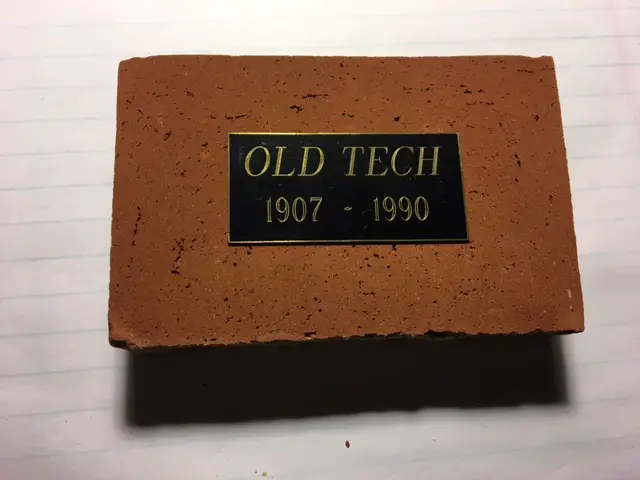
This is a slice of one of the bricks salvaged from the Old Tech building. Unfortunately, I believe the 1907 date is technically wrong. The building was built in 1901-02 and ready for occupancy in March of 1902. The full ownership of the building transferred to the College of Engineering at UC in 1907.
The Fenneman Room that was on the first floor of the Old Tech building has already transformed from history to legend because the now newer combined Geology/Physics building on the UC campus has no such gathering place for undergraduates.
This collaboration of memories between myself and Phil Clymer, a lifelong friend I met on my first geology field trip out West, is meant to preserve the memories created there and to inspire someone in the future to create a similar room at some college or university.
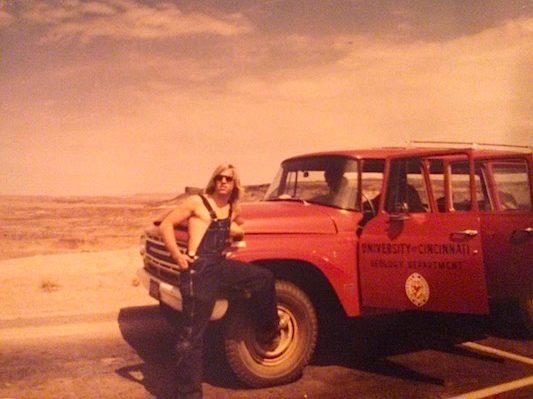
Here I am the summer of 1972. I was out West on my first geology field trip. Phil is the shadow in the passenger seat of Big Red, a beefy 4x4 International owned by the UC Geology department. I had met Phil for the first time just days before when about 20 of us went on a two-week Southwest field trip led by Dr. Len Larsen. Copyright 2022 Tim Carter
Phil and I spent countless hours in the room together along with many other geology students between 1972 and 1974. Other students got to enjoy the one-of-a-kind room for sixteen more years after we had graduated from UC. This article was created so the Fenneman Room doesn't become a myth.
The Fenneman Room was extraordinary as you’re about to discover. It quite possibly was the only room on the vast campus of UC that was set aside for undergraduates. Lifetime friendships were born and nourished in this room. Some students, like me, got to see the relaxed side of a few of the brilliant professors that spent time with us undergraduates in the room when they popped in to chit chat.
It’s hard to believe that a simple 12x14-foot space in a 70-year-old brick building with 12-foot ceilings could have such a profound and lasting effect on geology students, but trust us, it’s true as you’re about to discover.
The New Geology/Physics Building
Are you a geology major at the University of Cincinnati as you read this? Perhaps you’re pursuing a graduate degree or are a faculty member. You no doubt spend lots of your time in the combined Physics and Geology building who’s foundation roots penetrate into the clay soil of what used to be University Drive, a public road that once extended east from Clifton Avenue into Avondale.
When you exit the south doors under the dark and gloomy porte cochere of the combined Geology/Physics monolith, that valley in front of you used to be Snake Drive that slithered into the south end of Burnet Woods.
Time, under the guise of progress, has a tendency to erode important historical features, elements, and most of all, fond and pleasant memories.
The Old Tech Eon (Era?)
It’s been a few years since I’ve been in the sterile cast-concrete building you now call home, and I can’t recall if in the wide main hallways there might be a framed photograph of Old Tech. If not, you should do whatever is necessary to find one, frame it, and place it in the main lobby in a place of honor.
Old Tech was my geology building. Thousands of students and faculty who preceded me and Phil also called it home. Imagine how many students and teachers gather in Old Tech from the early 1900s until the large rectangular two-story brick building met its doom in 1990. You can see a photo of this happening at the end of this article I devoted to the Old Tech building.
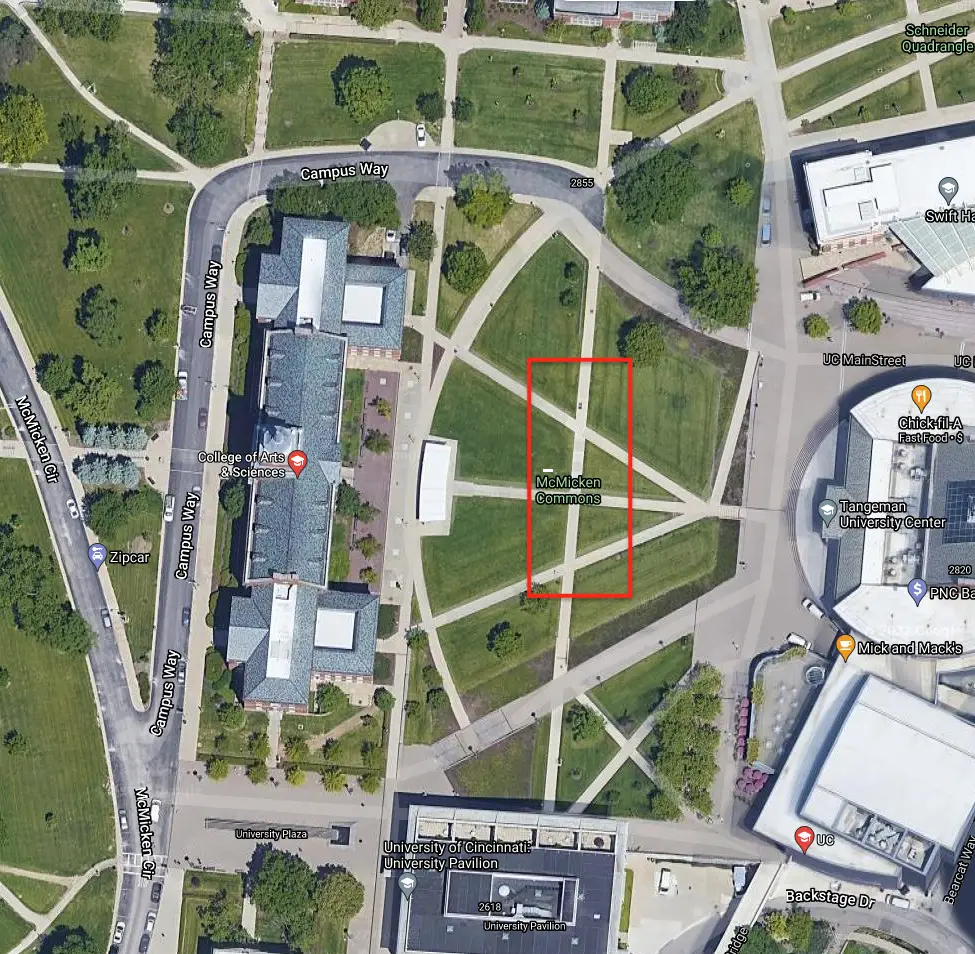
The red rectangle is the approximate location of the Old Tech building at the University of Cincinnati.
The Old Tech building came to be as a partnership between the University of Cincinnati and the Technical School of Cincinnati. You can read the entire history of the conception, construction, and renovation/expansion of Old Tech over the years here.
Phil and I attended UC from 1970-1974. At the time, Old Tech was the oldest standing building on the campus. Its grave is located due east of the landmark McMicken Hall College of Arts and Sciences in what is now the center of McMicken Commons. The red rectangle in the above satellite image of the UC campus shows the approximate location and size of Old Tech.
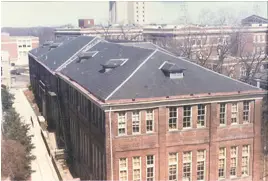
This is the south facade of Old Tech. You can see the wide sidewalk to the west that was a direct connection between the Physics building and bookstore and the Quadrangle just to the east of the Physics building.
Old Tech was a magnificent old solid brick building constructed between 1901 and 1902. I’d say the building was every bit of 50 feet wide and 200 feet long. Its foundation was built using hand-hammered pieces of the Bellevue Formation limestone probably harvested from the massive limestone quarry just 1/4 mile away that’s now Fairview Park.
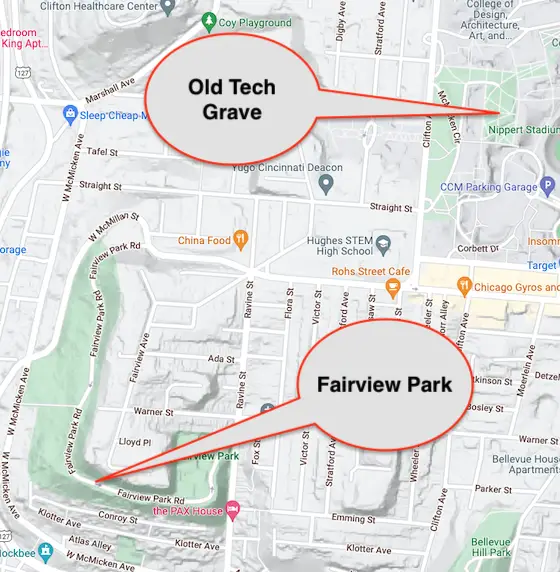
The L-shaped green area is the old huge limestone quarry. The foundation stone of thousands of nearby buildings was harvested from here. Copyright 2022 Google, Inc.
You can travel on the floor of this quarry if you walk or drive on Fairview Park Drive and look out across the Mill Creek Valley. This quarry provided foundation stone for thousands of houses and small businesses as well as stones for local retaining walls.
Old Tech's Floor Plan
Old Tech had a very structured layout. There was a center hall that ran north/south for the entire length of the building on both floors. When you entered the front door, you walked past a wide stairway that led to the second floor. There was a massive basement that had a huge darkroom where countless rolls of film were developed and black-and-white prints made for dissertations.
I spent many hours in this darkroom developing rolls of my own film as well as that of graduate students who had no darkroom skills. I also made hundreds and hundreds of black-and-white photographs of my own rock specimens and prints for graduate theses.
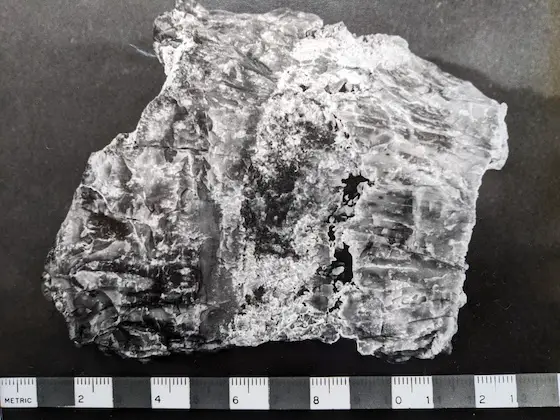
This is a photo I shot in the basement of Old Tech using the special light table and a macro lens. I then developed the film myself and made this 8x10 glossy print. Darkroom magic is now mythical. One wonders if you can even buy the chemicals used to develop film and prints. I still have the ruler used in this photo for scale!
The basement was also used for storage. The main pipe that provided the heat to the building entered into the basement. All the buildings on the UC campus got their heat and hot water from a central plant that was located at the north end of Nippert Stadium. All other mechanical aspects of the building could be found in the cavernous belly of this massive building.
Classrooms, administration offices, and faculty offices could be found on both floors. However, Old Tech had one special room that we are quite sure no other college department on campus had - The Fenneman Room.
This smallish room was on the first floor of Old Tech south of the center door and on the west side of the building. It was located between Dr. Paul Potter’s office and the fossil museum. He had the patience of Job and/or the plaster walls were so thick he never heard our hooting and hollering each day.
Dr. Potter could be heard in the early morning writing the outline of his day’s activity on his slate black board. He was famous for talking to himself while he wrote. On the other side of the room was the fossil museum, which was devoted to vast collections of Upper Ordovician fossils collected from the Cincinnati area.
The museum was also home to a skeleton that was rumored to be either a mammoth or perhaps a mastodon. In reality it was the skeleton of a circus elephant, named Old Chief, that had gone rogue while performing locally. He was a treasured guest, and the paleontology grad students who officed in the museum found that he made a dandy Christmas tree when adorned with some ornaments and colored lights.
There was an unverified rumor that Old Chief’s hide had been preserved and was in fact stored in the mysterious and off-limits attic space of Old Tech. Several student groups were thought to have attempted to breach the attic through the narrow and steep stairway located in one of the classrooms. Whether any succeeded in penetrating the space is unknown.
Thinking back on the furniture arrangement in the room, it was probably 14 x 12 feet. Its windows faced the wide sidewalk students used to get from the quadrangle to the Tangeman University Center (TUC) and all other buildings on the south side of the campus.
This concrete path was a superhighway of succulent eye candy for many of us male students overflowing with testosterone. Spring was the favorite time of year to open the large windows and admire the young lasses that would saunter by in halter tops, a clothing trend of the times.
In the 1970s and before, geology was primarily a male-dominated science. I could count on one hand the number of women undergrad and graduate students in our Geology Department between 1972-74. Over the next few years, that imbalance started to correct itself. Today, and it's a very good thing, there are many many women geologists, professors, and students. Someone needs to tamp down all the boisterous boys!
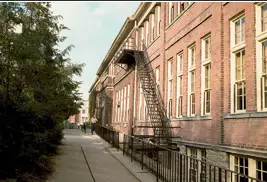
This is the west facing long wall of Old Tech. That sidewalk was alive with tasty eye candy each balmy spring day. The Fenneman Room windows were just below the fire escape platform you see at the second-story windows.
The Fenneman Room
This room was named after Nevin Fenneman, a famous geologist who had a very long career at UC. For all we know, it could have been his office. This simple space was given to the undergrad geology students as an informal place to meet, chat, study, tell tall tales, and who knows, maybe even kiss your girlfriend when alone on a Friday night sitting on the worn-out couch.
Every other undergrad on campus had to find their friends in the boisterous and crowded TUC building, the library, or sitting outside on the grassy knolls spread out all over campus in warm weather.
We geology students had our own comfortable private room to hang out and forge bonds with our peers, grad students, and the faculty.
Field Trips & Friendships
Getting a geology degree meant that the outdoors was also one of your classrooms. Local and long-distance field trips originating from the Fenneman Room were as common as cans of coveted Coors beer brought back from Colorado.
What better place to hunt for fossils than the exposed limestone and shale cliffs within miles of the Fenneman Room? These local rocks were part of the world-type section of the Upper Ordovician time period. That really didn't mean much to us undergrads, but the professors sure understood how lucky we were.
Who would think that humble Cincinnati, Ohio would also be one of the best places to study the enormous power of continental glaciers, the second-last one changing the course of the mighty Ohio River about 600,000 years ago.
Who would ever guess that Central Parkway was built on top of a glacial outwash plain created by ice-cold meltwater carrying untold tons of sand and gravel from the 3,000-foot-tall glacier just a few miles north of the present Mill Creek Valley? A field trip to the now abandoned Rack Sand and Gravel pit or the overlook at Alms Park on a crisp autumn Saturday morning to witness the power of Mother Nature is the stuff memories are made from.
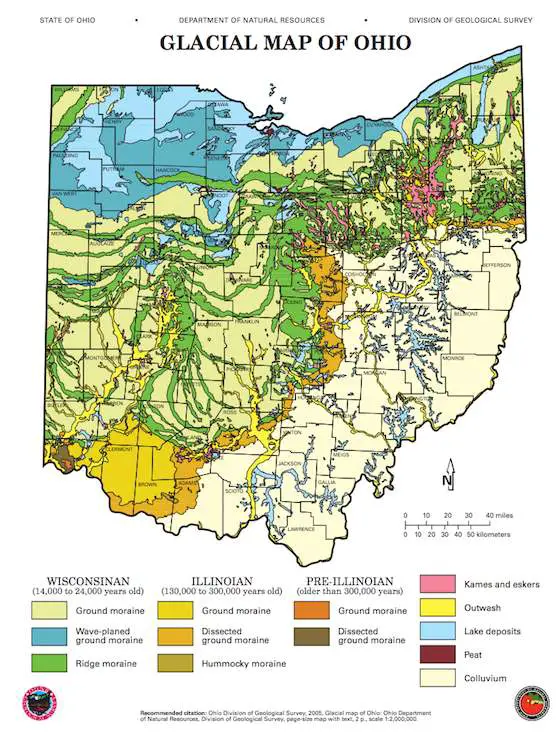
This is the glacial geology map of the state of Ohio. It shows the different geologic evidence of the massive continental glaciers. Copyright 2022 State of Ohio
Few, if any, other majors at UC had these required field trips. When you went on one, you got to see a slightly different side of your professor. A typical professor would tend to be far more rigid in a classroom inside Old Tech. The field trips allowed students and faculty to relax and this fuzzy relationship extended into the Fenneman Room.
Making it Our Own
The Fenneman Room had at its center a 6 to 7-foot-long standard table. It was identical to the others we sat at in the Old Tech classrooms. The one end of the table was jammed up tight against the window wall. The table was the center of activity, allowing some of us to finish assignments and homework, drink coffee in the morning, eat lunch, host debates, brag about rock or fossil samples, etc.
As you walked into the room, there was a small closet on your right where a refrigerator chugged away. On the south wall to your left a frumpy old couch accepted us and our guests. On several occasions my future wife and I would spend time in it during a break in classes senior year. At least one overstuffed upholstered chair was across from the couch next to the windows in the corner of the room.
There were no whiteboards, laptops, nor Internet back in the 1970s. Several discussions made it crystal clear we needed a large writing surface. One day Phil and I went hunting in all the dark spaces of Old Tech. Soon we discovered an old neglected blackboard.
Knowing we’d never get permission to install the board in our room, Phil and I decided to install it ourselves on the wall across from the windows just south of the door. We honed our fledgling home improvement skills one evening when everyone else had gone home. I remember borrowing my dad’s drill to install anchors to hold up the heavy slate. Looking back, we were so lucky we didn’t drill into a pipe or a wire! There's no doubt the professors saw this new improvement, but never questioned how it came to be.
The room was cozy, it was comfortable, and it was ours. It was an oasis of friendship and comradery.
Lunch with Lattman
Dr. Lawrence Lattman was the head of the Geology Department in the early 1970s. He was a brilliant geomorphologist with an outgoing personality. I distinctly remember several days he’d saunter into the room, pull up a chair, and proceed to eat his bagged lunch.
He’d tell tales of past field trips and share life lessons about all sorts of non-geology topics. You’d think it was your uncle in the room, not a dry and authoritarian professor. Dr. Lattman was a gentleman and he understood how to communicate with undergraduates like me.
Phil and I became friends with Dr. Lattman and I recall he hired us to paint the kitchen at his home just a few miles away in the gaslight district of Clifton. He may have had us do other work, but I don’t recall it at this time.
Dr. Lattman taught me two survival lessons. One was to always stay hydrated when out West. He talked about how the humidity is so low that when you perspire it almost immediately evaporates. Dehydration and death are constant threats during the summer in the Southwest.
He also talked about flash floods. I had no clue about these although I had seen them on a very small scale after heavy rain in Cincinnati. The issue is, he said, the storm can be 10 or 20 miles away and all of a sudden a sunny and dry gulch or wash where you may be camping or mapping could become flooded without warning in minutes. He warned us you could never outrun a flash flood. To survive you must immediately start climbing up and out of the gulch as fast as you can getting as high as possible.
Dr. Lattman was one great man and he was surrounded by quite a few other professors who made for an all-star geology faculty. Among them were Dr. Kenneth Caster, Dr. Len Larsen, Dr. Pryor, Dr. Warren Huff, Dr. Attila Kilinc, Dr. Sunderman, Dr. Rueben Bullard, and Mr. Richard Durrell.
The other was my physical chemistry professor Dr. John Alexander.
Lasting Bonds
As we worked on this article, Phil shared with me a single sentence that sums up how the Fenneman Room impacted my life. He said, “I can't imagine what our school lives would have been like without it.”
I can tell you what it would have been like. Empty.
I would have gone to class each day, walked out of each classroom to waste time somewhere in a very public noisy place on the UC campus. Or, I would have just gone home.
The Fenneman Room was like going into a toy shop with an ice cream stand in one corner and a penny candy case on another wall. It was a place of happiness.
Not all of my classmates spent time in the Fenneman Room. They missed out on so much in my opinion. They might not have memories of Lon Cooper's bravado.
They didn’t have to wear a winter jacket in the room senior year as did I when I was in the room at the same time as Lynn McClane. In the spring of our junior year we were an item but once we both went home for the summer I got back together with my high school sweetheart. When Lynn drove from Columbus one summer day as Phil and I were painting Dr. Larsen's stucco home, I didn't have the courage to come down the ladder and tell Lynn the truth. That was such a sad mistake. I regret to this day not giving her the respect she deserved. I doubt she'll ever forgive me and I fully understand.
They missed out on epic games of chess and tall tales of three young vivacious female entrepreneurs holding up a cardboard sign with $20 scrawled on it while cruising on I-40 at 75 mph in New Mexico.
The Fenneman Room, for those of us that recognized its power and allure, made my last three years of formal education the best I could ever imagine. I would never have thought a simple room could play such a big part in creating a family of lifetime friends, but it did.
If you didn’t have, nor don’t have now, a simple room dedicated to undergraduates, I feel sorry for you. If you’ve been financially successful and can make a room like this come to be in some future or existing college building, do it. Maybe one day a future student will write about the room named after you. What better way to add to your legacy!
The following content was provided by Phil Clymer:
My first entry into the world of Fenneman was in the fall quarter of 1972. I had completed the introductory course the previous year, and participated in the two-week summer field trip that had visited the Grand Canyon, including a memorable hike to the bottom, and numerous other National Parks.
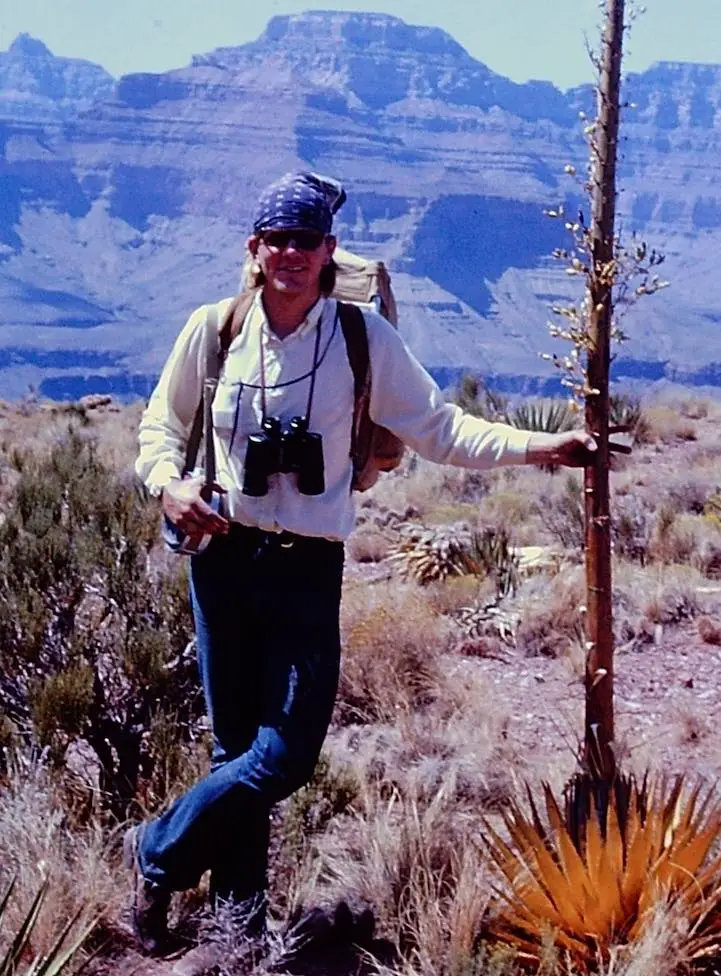
Here's Phil with his trademark bandana on holding up a tired yucca tree inside the Grand Canyon. Photo by Dr. Len Larsen
Multiple friendships were initiated on this trip, and after classes started, the familiar faces from the trip were seen within the confines of the special room with a sign on the door – Fenneman Room Lounge for Undergraduate Geology Majors. Could this be a joke? I was not aware of any major-specific rooms anywhere else on campus set aside for undergraduates. I gutted it up and entered into a new world.
The room was largely a place to hang out between classes, but also served as a lunch room. There was ample table space for unpacking a sack lunch. There was an antique refrigerator in the closet that worked well enough to preserve said lunches from spoilage. There was a badly worn sofa against the south wall, and I believe a couple of overstuffed easy chairs. There was a gigantic repurposed coffee urn that was kept full of hot water for making instant coffee and tea. There was an unwritten law that the first to arrive would fill the urn from the water tap in the lecture room across the hall, and turn it on so the later arrivals would have hot water available. Few of the undergrads had keys to the building so there was another agreement to secretly keep one of the windows unlocked so that an early arrival could crawl through the window to commence the day’s activity. We pooled our resources and purchased an inexpensive chess set that was left on the table for any to make use of.
The Fenneman room had multiple uses throughout the school year. It was the meeting point for Saturday field trips.
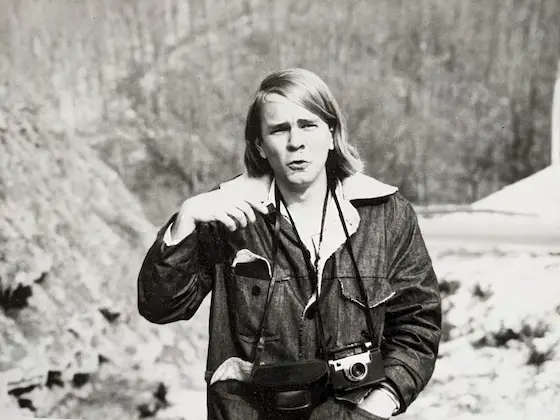
This is a photo I shot of Phil while on a typical Saturday field trip. You can see the interbedded Upper Ordovician limestone and shale to his right. If I were a betting man, I believe this photo was taken alongside I-74 as it was being connected to I-75 next to Mt. Airy Park.
It was occasionally utilized as a class room, particularly for the Saturday lab sessions for Caster’s Historical Geology, and for Lattman’s Field Methods. It was, of course, a gathering place for lunch breaks and during the school year nearly all of the faculty graced us with their presence at least once, and several on a regular basis. The faculty freely shared stories of their professional experiences outside of the classroom. Many of the graduate students came to hang out with the undergrads occasionally!
In the winter quarter of the year, we revived the Geology Club. We put a committee together and applied for official recognition from the University. We were on a roll! We decided to upgrade our club house – The Fenneman Room. We wanted to repaint it to cover the institutional color, but when we asked permission to paint we were told to forget it. There was an official color scheme, enforced by a panel more ruthless than any homeowners’ association.
In addition the painting would have to be done by the unionized UC painters and charged toward the maintenance budget for the building. If we did a pirate painting, if and when discovered, it would be repainted with the same penalty.
So instead we purchased a tectonic map of North America and wall paper pasted it to the south wall. We located an ancient slate chalkboard in a store room, we refinished the badly pitted surface and hung it on the wall. We had a talented seamstress friend of the organization, Connie Truthan, who made curtains for the windows to replace the roller shades. A cheap indoor/outdoor carpet was installed to cover the barely painted concrete floor. Someone donated an upgrade to our ancient refrigerator, and we sold the old one to a faculty member for five bucks who converted it into a fish smoker.
There was one more use for the room that bears mention. It was occasionally literally a home away from home if someone got stranded at school without transport. I utilized this option on several occasions, two times with humorous outcomes, at least for me. Dr. Davis entered what he thought was an empty room only to nearly jump out of his socks when he saw me stretched out on the sofa. The unfortunate custodian had a similar reaction another time.
But now back to our main purpose. What did the Fenneman Room mean to me? It was a lounge for between classes, it was a lunch room, a dormitory, a class room, a game room, and many other things. It was unique perhaps in the context of the larger university, as we were aware of no other department that provided space specifically for undergrad majors.
It was widely believed that biology and chemistry were flunk-out courses for the pre-med program. Whether or not this was accurate, it would hardly foster an attitude of cooperation between majors of those sciences. What we had in Geology was a place where we may be competitors, but also colleagues, and most importantly, friends. I maintain that the Fenneman Room fostered an environment for the development and cementing of friendships, some of which have survived the passage of a half century.
I returned to Old Tech a few years after graduation and was disappointed to find that most or all of the changes we made to the room had been undone.
The tectonic map had been removed, as well as the blackboard. The carpet had been removed and the floor was once again a mixture of badly worn gray floor paint and concrete polished smooth by the passage of countless footsteps.
The sign was still on the door but the room was unoccupied. I was even more surprised when I first visited the new combined Geology/Physics building to find there was no similar space reserved for the undergrads. I was told there was a break room for coffee etc. but it was reserved for faculty and graduate students. I was profoundly disappointed that they had discarded what to me and my classmates was a deeply treasured experience.